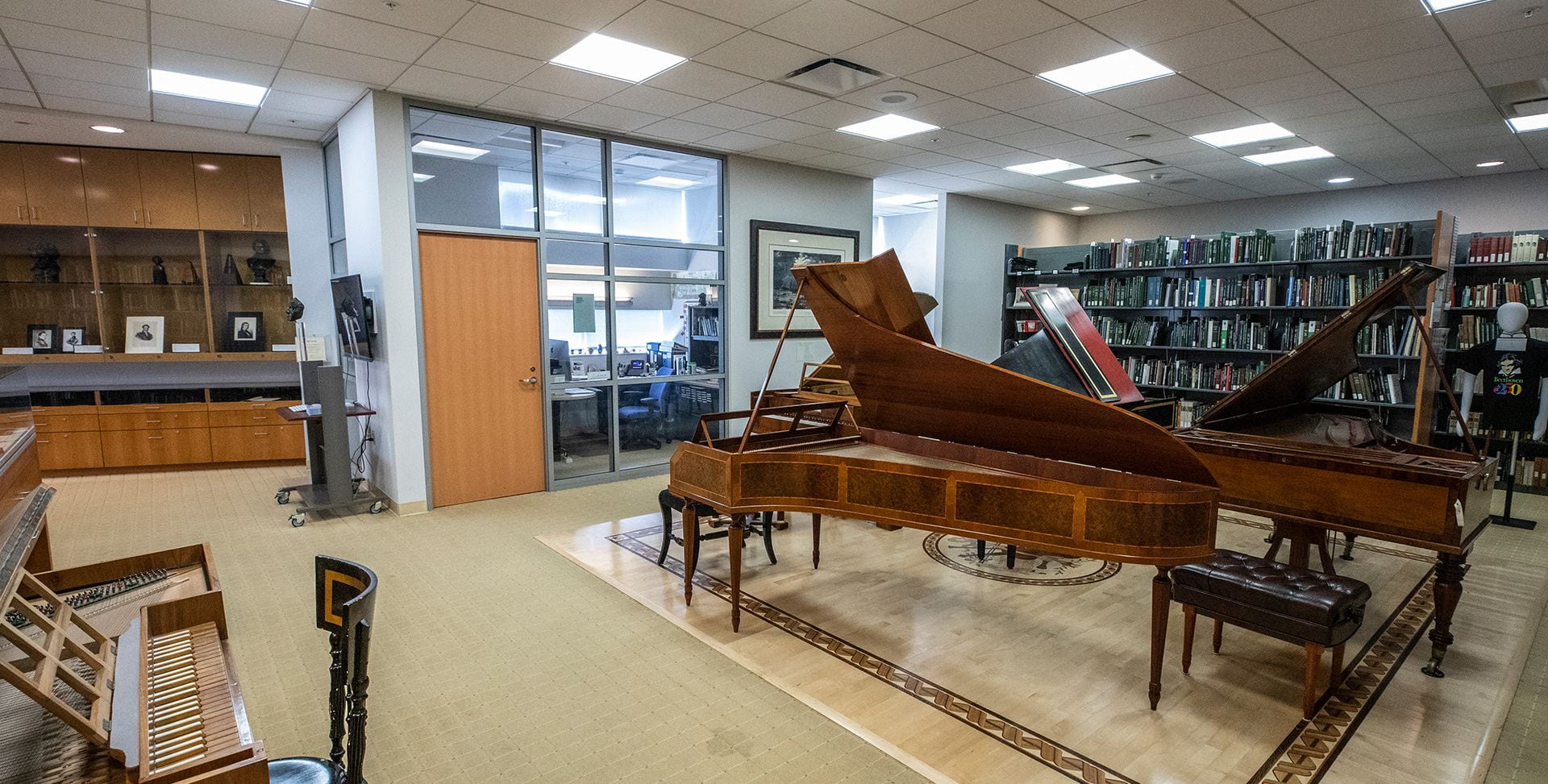Deep Dive in Five: The Ira F. Brilliant Center for Beethoven Studies

Nestled onto the fifth floor of San José State University’s Dr. Martin Luther King, Jr. Library, neighbor to SJSU’s Martha Heasley Cox Center for Steinbeck Studies and Special Collections and Archives, is yet another public scholarly resource: the Ira F. Brilliant Center for Beethoven Studies.
The Beethoven Center, established in 1985 thanks to the generosity of private collector Ira F. Brilliant, is home to an extensive collection of first and early editions of Beethoven’s work as well as manuscripts, engravings, sculptures and busts, multiple historic instruments and other artifacts. The collection has grown over the last three decades from the support of the center’s nonprofit partner, the American Beethoven Society.
Assistant Professor of Music Erica Buurman has served as the center’s director since 2019, where she collaborates with curator Patricia Stroh to create exhibitions, run events, support scholars and visitors, and edit the Beethoven Journal. She gave me a tour of the center for this latest installment of Deep Dive in Five.
1. What’s so special about Beethoven?

The Beethoven Center hosted its first social ball at the San José Women’s Club in spring 2022. Photo courtesy of Erica Buurman.
Erica Buurman (EB): Beethoven has a special place in music history. He is one of those influential figures whose work has become canonized the way that Shakepeare’s plays have been. He was an inescapable influence on later composers, especially in the 19th century, and he’s still an iconic figure. He’s the archetypal romantic artist. There are 200 years of scholarship on him alone.
2. How can visitors engage with the Beethoven Center?
EB: Anyone can visit the center five days a week. Visitors can experience hands-on demonstrations of the center’s historic keyboard instruments, which include two original fortepianos from the 1820s as well as replicas of an eighteenth-century harpsichord, clavichord, and fortepiano.
We always have items on display — sculptures, engravings, early and first-edition scores. We rotate our exhibits. We even have a lock of Beethoven’s hair that people can see in a display case. This lock, along with others housed in other collections around the world, is playing an important role in a DNA sequencing project led by scientists internationally.
In addition to visiting the center, we have the Beethoven Gateway Project, an ongoing effort to digitize our first- and early-edition scores, as well as our artwork, engravings and other resources. Musicians and scholars often refer to these items, and sometimes we have the only copy or one of the few copies available. The Gateway also includes a bibliography database of literature about Beethoven; it was one of the first bibliography resources to go digital.
We also offer tours to classes and the public, as well as concerts and lecture series on occasion. Earlier this year, we hosted our first Beethoven social ball in partnership with the College of the Humanities and the Arts.
3. What’s a common misconception about Beethoven?
EB: In some ways, Beethoven is a victim of his own success. Those few works of his that everyone knows — the big symphonies, like the Fifth, and also the famous portraits of him scowling — have given people the idea of him as this grumpy, temperamental genius who wrote serious music that is difficult to play. But there are lots of sides to Beethoven’s music: from funny to sweet and gentle or even bizarre. I think Beethoven is best appreciated when you consider the whole spectrum of his art.
4. What’s your favorite item in the collection?
EB: My favorite item is something that was added to the collection in 2018: a first-edition score of Beethoven’s Seventh Symphony that he inscribed to a friend. What makes it so special is that we didn’t know it existed until it came on the market a few years ago after having showed up in someone’s personal collection in California, and it’s rare to find something unknown about someone whose life was so documented.
Beethoven often inscribed scores that he gave to friends as gifts, but this one is particularly special because it’s the only occasion where he inscribed a symphony to a woman, namely the noblewoman Antonie Brentano. In the 19th century, composers usually gifted women piano music and songs that were meant to be played in the home, while symphonies were considered professional, public genres, so they tended to be given to men. There’s been a lot of speculation about whether or not Beethoven was in love with Antonie, and it’s a sign of his regard for her woman that he gave her this score.
5. What exciting things are happening at the Beethoven Center in 2023?
EB: We’re hosting a conference on chamber music this February, and putting on an exhibition dedicated to Beethoven’s chamber music. We’ll display many of our first-edition scores, and we’ve invited the world-class Takács String Quartet to perform.
I’ve also been working with Jon Oakes in the King Library Experiential Virtual Reality (KLEVR) lab. We are working on a project with two professional dancers wearing motion capture suits while they perform dances from Beethoven’s period. We had the Early Music Ensemble from the Music Department record some of Beethoven’s dance music, and we hope to create an interactive 3D model of these dances, which will be fun to watch and also potentially useful for musicians to visualize what the music was written for.
It’s amazing that SJSU has this collection at our fingertips. The center is housed at San José State but it’s also public-facing, and the exhibits and concerts we offer are geared at the public. Being an academic, sometimes you get stuck in a university bubble, and you wonder if you’re only talking to other scholars. But here, it’s so nice to be reminded that people love Beethoven.




